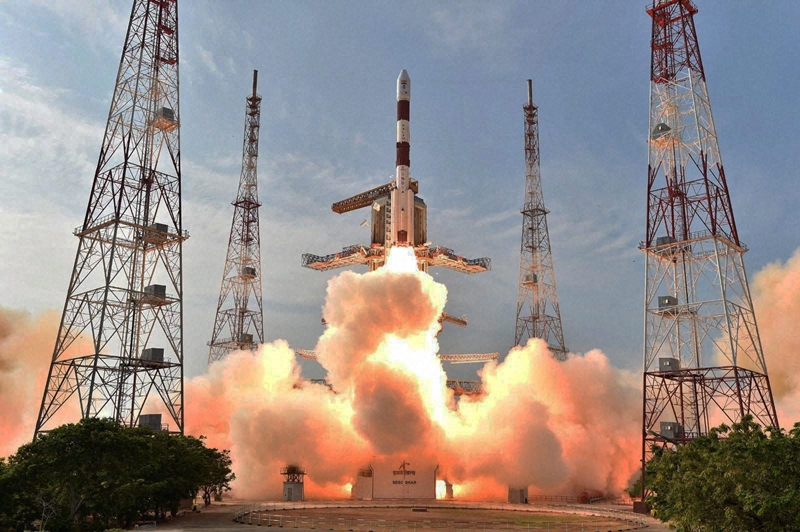As part of its aspirations to build a regional navigational system equivalent to Global Positioning System of the US, ISRO plans to send seven satellites to put in place the Indian Regional Navigational Satellite System (IRNSS). The satellite (IRNSS-1F) is the sixth out of seven satellites in the Indian Regional Navigational Satellite System (IRNSS). It has a mass of some 1.425 metric tons and its dimensions are 5.18 x 4.92 x 4.92 feet (1.58 x 1.5 x 1.5 meters). It can generate up to 1,660 W of power.
IRNSS is a satellite-based positioning system for critical national applications. Its main objective is to provide reliable position, navigation, and timing services over India and its neighborhood. It is expected to grant accuracy of better than 66 feet (20 meters) in the primary service area. It is designed to provide accurate position information service to users in India as well as the region extending up to 1500 km from its boundary, which is its primary service area. IRNSS will provide two types of services, namely, Standard Positioning Service (SPS) which is provided to all the users and Restricted Service (RS), which is an encrypted service provided only to the authorised users. The IRNSS System is expected to provide a position accuracy of better than 20 m in the primary service area.
Some other applications of the system are:
Terrestrial, Aerial and Marine Navigation, Disaster Management, Vehicle tracking and fleet management, Integration with mobile phones, Precise Timing, Mapping and Geodetic data capture, Terrestrial navigation aid for hikers and travellers, Visual and voice navigation for drivers.
Quoting the former ISRO Chief, Dr K Radhakrishnan,
“The requirement of such a navigation system is needed because access to foreign government-controlled global navigation satellite systems can be restricted and become disturbed in hostile situations. The IRNSS would provide two services, with the Standard Positioning Service open for civilian use and the Restricted Service, encrypted one, for authorised users (military).”
The IRNSS fleet is expected to be complete by April 2016.
ISRO has used its workhorse rocket, the PSLV. The four-stage PSLV is India’s most reliable launch vehicle. It has been in service for more than two decades and has been used to launch satellites for many iconic missions, such as Chandrayaan-1, the Mars Orbiter Mission (MOM), the Space Capsule Recovery Experiment, as well as the IRNSS system.
Congratulations to ISRO Team on successful launch of IRNSS IF into orbit #PresidentMukherjee
— President Mukherjee (@POI13) March 10, 2016
The rocket has been used to place more than 40 satellites into orbit for some 19 nations. PSLV is capable of lifting up to 3.25 metric tons to low-Earth orbit and about 1.42 metric tons to a geosynchronous transfer orbit (GTO).
The mission, designated PSLV-C32, is the 34th flight of the PSLV booster. It is slated to last approximately 20 minutes and 11 seconds, ending with spacecraft separation at an altitude of 304 miles (489 kilometers). Lastly, the satellite will be delivered to a geostationary transfer orbit (GTO), inclined 17.86 degrees. It is expected to be operational for up to 12 years.
The configuration of IRNSS-1F is similar to its predecessors: IRNSS-1A, 1B, 1C, 1D, and 1E. The first IRNSS satellite (IRNSS-1A) was launched by a PSLV rocket on July 1, 2013, from the Satish Dhawan Space Centre. The most recent satellite in the series, IRNSS-1E, was sent into orbit on Jan. 20, 2016, also by a PSLV booster. The next IRNSS spacecraft (IRNSS-1G) is expected to be launched in April 2016; while four satellites are sufficient to start operation of IRNSS system, seven would make it more accurate & efficient.
Successful launch of IRNSS-1F is an accomplishment we all take immense pride in. I salute the hardwork of our scientists & @isro.
— Narendra Modi (@narendramodi) March 10, 2016
Thursday’s mission is India’s second launch this year. The next flight, using the same rocket, is currently scheduled to take place in April when a PSLV-XL rocket will send the IRNSS-1G navigation satellite into orbit completing the IRNSS system & placing India into a select group of nations who possess such a system.
With inputs from isro.gov.in
